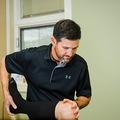.jpg)
The Foot and Ankle: How and Why We Evaluate
Patients commonly present with foot and ankle problems to our office. We also
find biomechanical problems in the feet and ankles that may relate to other
musculoskeletal issues such as knee, hip, and low back issues. This relationship
is common as the complexity of the feet and ankles influence the rest of the
body.
There are twenty-six bones, and more than 100 ligaments, tendons, and
muscles in each foot. They provide essential functions such as supporting our
body weight, providing balance, shock absorption, and transferring ground
reaction force.
Anatomy
The three bony categories of the foot are the forefoot, midfoot and rear foot. The
forefoot is made up of the toes and sesamoid bones, the midfoot contains the
tarsals that form the foot's middle region or arch, and the heel and the talus
make up the rearfoot.
In addition to bones, the foot contains several muscles such as the flexors,
extensors, peroneus longus and brevis, in addition to the tibialis posterior and
anterior. Each of these muscles helps specific parts of the foot move and
contributes to its stability.
The ligaments and tendons attach bones to other bones and muscles. One
notable ligament is the plantar fascia, which joins the heel and base of the toes.
This tissue is important in helping to maintain the longitudinal arch of the foot.
The Achilles tendon is one of the foot's most important such feature. This piece
of soft tissue connects the leg and heel and is under heavy load with activities
like walking, jumping, and running.
Foot Biomechanics
During normal gait, your heel will contact the ground first. This is known as foot
strike. As your body moves ahead, your weight rolls forward onto your midfoot.
This is the stance phase. The arch structure relaxes and rolls inward (pronation)
for a moment, so your weight is spread evenly over the foot. When your body
continues forward, the foot rolls to the outside (supination) and rests on the toes
to push off. Finally, you lift the entire leg and move it forward. This is the swing
phase. Once you plant the heel again this completes a gait cycle.
The foot and ankle are unique, in that they work together to allow the foot to
mobile or stable when it needs to. This is necessary for normal gait to take
place. Foot problems often result when weak soft tissues or stiffness in the joints
are present. This can result in problems in and around the foot or up the kinetic
chain.
Common Foot Problems
Foot pain and ankle pain are common occurrences that everyone will experience
from time to time. It can lead to problems like bunions, toe deformities,
metatarsalgia (forefoot pain), fallen arches, sprains, shin splints, and many
other conditions that cause pain and limit your ability to move and function.
The Evaluation Process
When diagnosing potential foot and ankle issues, we must consider local mobility
and stability of the foot and ankle as well as a patient’s gait. A gait analysis is
the method in which people walk or run, and how it may relate to other clinical
findings.
Contact Us
Individuals residing in the Des Moines, Clive, and Waukee areas with issues
related to their feet and ankles are strongly encouraged to contact Shaw
Chiropractic & Sports Injury Center.




